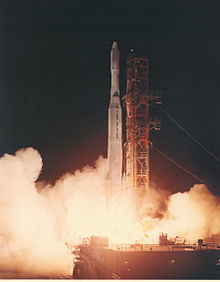Delta M
 Launch of the first Delta M with Intelsat 301 | |
| Function | Expendable launch system |
|---|---|
| Country of origin | |
| Launch history | |
| Status | Retired |
| Launch sites | Cape Canaveral LC-17A |
| Total launches | 13 |
| Success(es) | 11 |
| Failure(s) | 2 |
| First flight | 18 September 1968 |
| Last flight | 17 March 1971 |
The Delta M or Thor-Delta M was an American expendable launch system used for thirteen orbital launches between 1968 and 1971. It was a member of the Delta family of rockets.
The Delta M had a three-stage configuration. The first stage was the Long Tank Thor, a stretched version of the Thor missile, previously flown on the Delta L. Three Castor-2 solid rocket boosters were attached to the first stage to increase thrust at lift-off. A Delta E was used as the second stage, and the third stage was a Star-37D solid rocket motor. On the final flight, six boosters were flown instead of three, in a configuration known as the Delta M6, or "Super Six".
All thirteen launches were made from Launch Complex 17A at the Cape Canaveral Air Force Station. The first launch (carrying Intelsat 301) on September 18, 1968 was a complete failure when the first stage began suffering abnormal pitch gyrations starting at T+20 seconds. The booster maintained a stable attitude until around T+100 seconds when it pitched over and began to break up from structural loads. As the Delta was also headed back towards land, Range Safety sent the destruct signal at T+108 seconds. The fifth launch on July 25, 1969 (Intelsat 305) suffered a rupture of either the third stage casing or nozzle and ended up in an unusable orbit. Of the thirteen launches, twelve carried geosynchronous communications satellites. The thirteenth, which was the final flight and the only one in the M6 configuration, placed Explorer 43 into a highly elliptical orbit.
References
- Wade, Mark. "Delta". Encyclopedia Astronautica. Retrieved 2009-02-11.
- Krebs, Gunter. "Thor family". Gunter's Space Page. Retrieved 2009-02-11.

